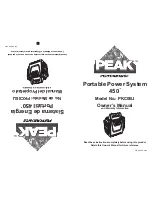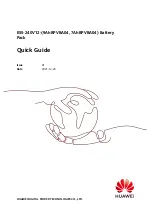
www.lesterelectrical.com
5
00870E
1.
CHARGER DOES NOT TURN ON
2.
CHARGER FUSE BLOWS
3.
THE AMMETER NEEDLE REMAINS AT 30
AMPS FOR MORE THAN ONE-HALF (½)
HOUR
4.
CHARGER DOES NOT TURN OFF
5.
AC LINE FUSE OR CIRCUIT BREAKER
BLOWS
If the problem is other than listed above, refer to a
qualified service agent for additional troubleshooting
procedures.
1.
Charger does not turn on
The DC plug must be disconnected and
reconnected to start the charger after turn-off.
Connect the power supply cord securely to a live
AC outlet. Visually inspect the DC output plug
and battery receptacle to be sure they are in
good working condition.
WARNING: IF THE PLUG OR RECEPTACLE
IS BROKEN, TWISTED, BENT OR LOOSE AND
DOES NOT MAKE GOOD ELECTRICAL
CONTACT, HAVE IT REPLACED BY A
QUALIFIED SERVICE AGENT IMMEDIATELY. DO
NOT USE THIS CHARGER IN THIS CONDITION
AS FIRE OR PERSONAL INJURY CAN RESULT.
If the plug and receptacle are good, connect the
DC plug into the receptacle and listen for the
power relay inside the charger to "click" on
within 5 seconds. If the "click" is not heard,
remove the DC plug from the receptacle and
connect the DC plug of another charger, which
you know is operating properly, to the
receptacle.
If still no "click" is heard, a malfunction in the
batteries or receptacle wiring exists. If the
"click" is heard, the batteries and receptacle are
good, and a malfunction exists in the original
charger.
If the relay "click" is heard, a hum from the
transformer should be heard and the ammeter
should indicate the charge rate. If no
transformer hum is heard, check to be sure the
AC power supply cord is securely connected to
a live AC outlet. When three-prong to two-prong
adapters are used, they tend to work loose,
resulting in a poor connection. Check the AC
line fuse or circuit breaker and, if possible,
connect a functioning charger, utility light, or
other electrical appliance to the outlet to verify
the presence of AC power. If AC power is
present, and still no transformer hum is heard,
the charger is malfunctioning. If the relay
"clicks" and the transformer hums, but no charge
rate is indicated on the ammeter, the charger is
malfunctioning.
2.
Charger fuse blows
The charger fuse assembly consists of a double-
ended fuse wire visible through a transparent
cover mounted on the front panel. Each half of
the fuse wire serves as an individual fuse link
which protects the charger in the event one or
both rectifier diodes fail, or a reverse polarity
connection is made to the batteries.
Check the fuse assembly visually for an open or
blown fuse link. If both half links of the fuse
assembly blow as soon as the DC output plug is
connected to the battery receptacle, the polarity
of the batteries may be reversed. If no battery
or receptacle maintenance has been performed
prior to the fuse blowing, the charger is
malfunctioning. If only one half link blows, the
charge rate will be low and the charger is
malfunctioning.
CAUTION: DO NOT USE THE CHARGER IF
THE OUTPUT IS LOW. BATTERIES WILL NOT
REACH FULL CHARGE, THEREBY INCREASING
THE POSSIBILITY OF A HARMFUL DEEP
DISCHARGE DURING THEIR NEXT USE.
3.
Ammeter needle remains at 30 amps for
more than one-half (½) hour
This condition normally results if the charger is
connected to a battery system which is less than
36 volts. If connected to a 12-, 18-, 24-, or 30-
volt battery system, the charge rate will not taper
below 30 amps within 30 minutes. This may
also result if a 36-volt battery system is wired
incorrectly or if the battery polarity markings are
reversed. Have a qualified service agent check
the wiring of the batteries and the charging
receptacle.
CAUTION: DO NOT CONNECT THE
CHARGER TO BATTERY PACKS WHICH ARE
NOT 36-VOLT SYSTEMS. OVERHEATING AND
TRANSFORMER BURN-OUT WILL RESULT.
4.
Charger does not turn off
New batteries or batteries charged in cold
temperatures may require an extended charge
time to achieve full charge. However, if the
charger runs for more than 18 hours without
shutting off, the charger is malfunctioning
.
5.
AC line fuse or circuit breaker blows
If this occurs, the charger may be malfunctioning
or the AC line fuse/circuit breaker may be
"weak". Connect another charger, which you
know is operating properly, to the same AC
outlet. If the fuse/circuit breaker still blows, have
a qualified electrician check for a "weak" line
fuse/circuit breaker. If the line fuse/circuit
breaker works properly with the second charger,
the original charger is malfunctioning.

























